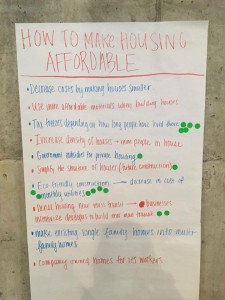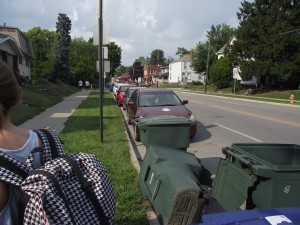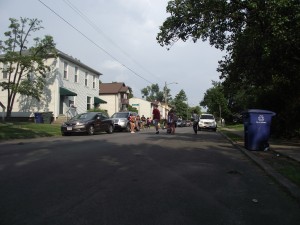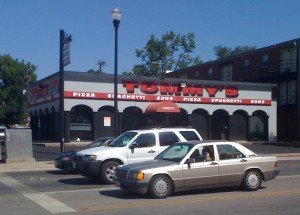Author: Linya Cheng
Explore Nation: How to Make Housing More Affordable
Out of our ten different ideas to make housing more affordable, the three chosen most by the class were putting tax freezes on certain residents, depending on how long they’ve lived there, building with more eco-friendly materials, which will decrease the cost of monthly utilities, and allowing businesses or corporations to incentivize developers to build dense housing near mass transit.
A tax freeze means the tax rate does not increase for people who have lived in their homes for a long time. It helps prevent gentrification by making sure people who have lived in their neighborhoods do not need to worry about the area becoming too expensive to live in when new people move in. Take Brooklyn, New York for example. This area, for a long time, was a cheap place to live that was very close to downtown and midtown Manhattan. However, because of its cheap prices and proximity to Manhattan, many people purchased land and changed it causing gentrification and forcing people who could not afford to live in the neighborhoods to move out. If there were more tax freezes, people would have been able to afford to live in their neighborhoods plus all the new public goods that came with new residents.
Allowing businesses to give money to housing developments near mass transit will allow residents living there a reliable and relatively cheap mode of transportation. Because of this, business owners can more reliably know their workers will be able to get to work, giving them more reliable workers that regularly come to work on time, which gives them the incentive to pay for housing near mass transit. This practice makes these houses available to low income families. Additionally, these families will have a cost efficient way to get to work, lowering the cost of their daily commute.
Finally, our group’s favorite solution is to use more eco-friendly materials in construction. By doing so, the cost of utilities and the environmental impact will decrease. For example, using energy efficient windows will keep heat and air conditioning in, creating a more stable environment in which the amount of energy used to heat and cool the house will decrease, lowering the cost of utilities. Energy efficient appliances like lightbulbs, refrigerators, dishwashers, and air conditioners can also be installed to save on monthly costs. Other sustainable practices include using recycled building materials such as engineered lumber, fly ash concrete, steel, tile, or cotton insulation. Metal roofs can save on energy, collect rainwater, and can lower homeowners insurance. Landscaping around the house can be strategically chosen and placed to provide shading, cooling, and protection from wind and noise. While all of these eco-friendly practices make housing more affordable in the long run, they also improve occupant health, comfort, productivity, and reduce pollution and landfill waste.
Explore Nation: How to Think Like a Planner| City DNA
1. 2207-209 NEIL AVENUE
Measuring data:
Lot width: 32 ft; Lot length: 80 ft; Front setback: 14 ft; Side setback: 4.5ft
Approximate lot coverage: 85%
Sidewalk width: 6ft ; (Probable) Right-of-way: 70ft (16 ft property*2, 11ft street lane*4)
- Residents park vehicles in street and behind property
- Alley most likely decreases resident’s happiness
- Parking lot, gravel, garbage
- Property’s land use is residential
- Surrounding are commercial and residential. It seems compatible with the residents, as they seemed to enjoy drinking and loud music as the commercial areas are a bar and gas station. This immediate area, however, does not seem planned.
- Yes, it makes the area seem darker and less neighborhood-like.
- The benefits are that you are close to campus and restaurants. However, the neighborhood seems like a place typically for parties and does not seem to be appropriate for studying.


2. Norwich Avenue
- The street would probably have decent lighting, but there are only lights on the north side of the street. However, the trees are all on the south side of the street, making it very dark on that side; the lighting would probably be low to medium level. The street lights seem about 100ft apart.
- There are power lines in the right-of-way, most likely because it is a low density neighborhood that does not require them to be buried, typically because of cost efficiency and contact with other, higher utilities, such as water or sewage.
- Yes, the character changes; it becomes quieter and there is a lower volume of traffic. It seems more peaceful and less hectic. The one way streets and less available access to main avenues make it inconvenient for partiers and others to access the street, aside from those that are residents.
3. Measure Norwich avenue’s Street Width and Sidewalks
- The street width makes it difficult to drive fast. If the street were wider, there would be more induced demand and more traffic would come through, making it more dangerous. It would make the street less walkable and more for cars (Columbus’ walk score is only 47).
- The on-street parking seems to be effective, and on-street parking is a good idea for pedestrians because it creates a barrier between moving traffic and the sidewalk, making it a safer walk.
- The sidewalks to be a standard size and two, average-sized people are able to pass each other.
4. Estimate the average front and side setbacks of structures on Norwich.
5. 128-134 W Norwich Avenue (NE corner of Norwich and Williams)
- The footprint and setback of the building on this property makes the neighborhood feel less walkable and more car oriented, especially with the parking lot in the front yard.
6. Williams street and Unnamed Alley
- The parking configuration is not functional. The parking spots are on rough pavement that needs to be redone, and the lines are too long and not efficient. The lines should be shorter, and there should be ways for people to get in and out of their parking spaces without parking typical suburban-home style.

7. Northwood avenue and Williams Street
- The wall seems to act as a barrier between the front yard and the street life, making the neighborhood feel closed off on the south side of the street. Interactions with neighbors would be less likely to happen
- .

8. Northwood Avenue Measurements
- The width of Northwood Avenue is approximately the same as Norwich Avenue, 32ft. The direction of the street happens to run opposite but still parallel to Norwich.
- The sidewalk on the south side of the street is only 4.5 ft compared to 5.5 ft on the north side of the street. The north sidewalk also seems to be in newer and better condition, perhaps because it is more travelled in comparison to the side of the street with the walls.
- It is a good idea for the street to be one-way because it helps make sure traffic is able to flow through the short distances between the main avenues, Neil and High, and makes the volume of the traffic lower. It also provides more parallel parking, which helps to create a barrier between the street and the pedestrian as parking is allowed on both streets. Because the street doesn’t have painted lines, drivers subconsciously feel that they should drive slower, and trees on the street help (which are statistically shown to slow traffic down). Cons, however, are that it makes a drive in the neighborhood more difficult if you are thinking from a car-vantage point.
9. Estimate the average front setback of structures on Northwood
- Approximately 25ft setback, 8ft side length.
10. 2244 Neil Avenue
- It appears to have boarded up former garage doors, typical of a firehouse that would help keep the neighborhood safe. It is now a real estate office that should either be reutilized as a sort of grocery store or bodega, or demolished to make room for low/medium density housing. It is probably zoned as a low density commercial zone or office.
11. 174 W.Lane Avenue (Tommy’s Pizza)
- It’s a very bad practice; it’s impractical, makes it difficult to walk through that area if there are cars parked near the sidewalk, and makes it difficult to see where the street ends and the lot begins.

